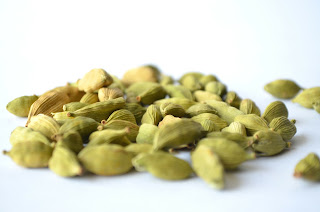Elettaria cardamomum (L.) Maton is known as the "Queen of spices" for its pleasant aroma and taste. It is the third most expensive spice after saffron and vanilla.
- Ilayachi (Hindi)
- Cardamom
- Grains of Paradise
- Elam, elakkai (Malayalam)
- Elettari (Tamil)
Geographical source : It is widely cultivated in south India and Sri Lanka. It is cultivated in altitudes ranging from 900 to 1400 m above mean sea level.
Elettaria cardamomum is a herbaceous perennial plant that grows 2 - 4 m in height. It have underground rhizomes and is propagated by vegetative division of these rhizomes. The leaves are 30 to 35 cm long and dark green in colour. Flowers of most cardamom types are white with the central lip streaked with pink. Flowers are bisexual and irregular. Fruit is an inferior and have trilocular capsule. The fruit colour is green and terns golden yellow on ripening. Its seeds are up to 4 mm in length. The odour is aromatic.
Chemical constituents:
Cardamom contain carbohydrates, proteins, terpenoids, carotenoids, flavonoids, lipids and essential oils. The volatile oil extracted from cardamom contain eucalyptol (cineole), terpineol, linalool, borneol, sabinene, α-terpinyl acetate etc.
- Cardamom seeds are is aromatic, which is widely used as a flavouring agent in Asian cuisines.
- It is also a stimulant, stomachic, diuretic and carminative.
- It is used in aroma therapy.
- Cardamom capsule is used to control asthma, teeth and gum infections, digestive problems and nausea.
- It has antioxidant, antibacterial, anti-inflammatory, antifungal, anticancer, gastro-protective, antidiabetic and insecticidal activities.
For further reading:
- Kaliyaperumal Ashokkumar et al., 2020, "Botany, traditional uses, phytochemistry and biological activities of Cardamom [Elettaria cardamomum (L.) Maton] - A critical review", Journal of ethnopharmacology, 246.


No comments:
Post a Comment